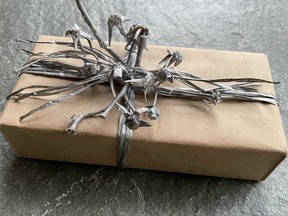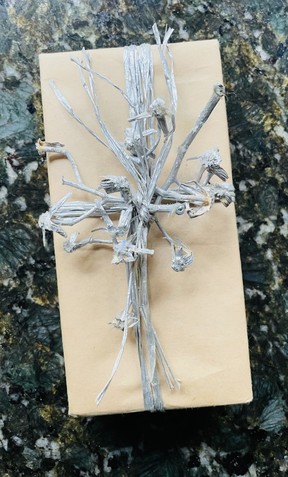Gift wrapping is expensive, time consuming and an environmental nightmare. Why, then, do we love it so?

Reviews and recommendations are unbiased and products are independently selected. Postmedia may earn an affiliate commission from purchases made through links on this page.
Starting right about now, we become a nation of cottage crafters.
A nation of meticulous measurers and folders of fine fidelity.
Start your day with a roundup of B.C.-focused news and opinion delivered straight to your inbox at 7 a.m., Monday to Friday.
Thanks for signing up!
A welcome email is on its way. If you don't see it, please check your junk folder.
The next issue of Sunrise presented by Vancouver Sun will soon be in your inbox.
Any large horizontal expanse will be commandeered for the seasonal campaign.
The dining room table is out of commission.
The spare bedroom becomes a no fly-zone.
T’is the season of scissors and tape.
Of tags and ribbons.
Gift wrapping season has arrived.
You either love it or you hate it. You’re either a wrapper or a whiner.
We may be divided in our love of gift wrapping but the statistics indicate that we are committed to it in a big way. Statista, the German survey company that specializes in market and consumer data says that, by 2025, the global market for gift wrappings will hit US$24.9 billion. That’s a staggering sum when you consider that it’s not the thing itself, but the thing that gets discarded.
But throwing away wrapping paper is complicated. A great deal of it isn’t recyclable or compostable. It’s laminated, heavily dyed, bespangled, and synthetic. And you know how something like thread can snare your vacuum cleaner beater bar? In the time it takes to say, “Oh, you shouldn’t have,” a strand of ribbon can gum up the machinery at a paper recycling facility. Scotch Tape is another contamination problem. At least a fraction of the six million rolls of tape we buy each year will sneak into paper recycling facilities when it ought to go into flexible plastic recycling.
When it comes to Christmas waste, the figure that gets bandied about is 540,000 tonnes.
According to Zero Waste Canada that’s the weight of what Canadians will send to the landfill following the holiday. Greenpeace provides this particularly Canadian visual: we throw away enough wrapping paper to cover 45,000 hockey rinks.

So, gift wrapping is expensive, time consuming and an environmental nightmare. Why, then, do we love it so?
A Journal of Consumer Psychology report found that we appreciate an item more when we have the pleasure of unwrapping it. If the gift is from someone close to us, however, it can have slapdash wrapping. If it’s from an acquaintance, the wrapping will be used as a gauge of the relationship. An oft-cited study from Southern Methodist University in Dallas found that there is a correlative valuation of the gift to the wrapping. One ought to be commensurate with the other. Meaning, the findings showed that we are disappointed when the elaborate package reveals a lacklustre gift, but that nice wrapping somehow confers extra value on a simple gift.
So, here’s a holiday tip: don’t let your wrapping oversell the contents of your gift.
Commercial wrapping paper itself is a relatively recent invention. It hails from a stationary store in Kansas. In 1917, the proprietors, the Halls, ran out of the coloured tissue that was usually sold to wrap gifts in. In its place, they offered French envelope liners at ten cents a sheet. The paper was a hit. It launched a fortune for the Halls. You may have heard of these stationers. They went on to become Hallmark.
For years now, I’ve been using old calendars and catalogues, old cereal boxes and, of course, the funnies and brown paper bags, to wrap gifts. I use hard shell plastic to make glamorous, reusable gift tags and one innovation ought to land me in the Waste Stream Diversion Hall of Fame. I’m including a photo of it here.
The first person who correctly identifies the ‘bow’, well, how would you like a half dozen of those glamorous, environmentally-responsible tags?
Jane Macdougall is a freelance writer and former National Post columnist who lives in Vancouver. She will be writing on The Bookless Club every Saturday online and in The Vancouver Sun. For more of what Jane’s up to, check out her website, janemacdougall.com
This week’s question for readers:
Where do you sit on the wrapping spectrum? How does your family handle this seasonal chore. Are you making earth-friendly changes?
Send your answers by email text, not an attachment, in 100 words or less, along with your full name to Jane at thebooklessclub@gmail.com. We will print some next week in this space.
Responses to last week’s question for readers:
Are you your pet’s chef? What goes in your pet’s bowl?
• Top quality dog food gives you a top quality dog. It’s nice to augment kibble, but the kibble has got to be good. Read those labels. Save yourself some vet bills.
Mike McDonald
• My husband often jokes that our two girls, Sunny and Piper, our eight-year-old mixed breed rescues eat better than we do. He may be right.
Our girls are my personal trainers and my cherished confidants — thank goodness they don’t speak.
We have been making homemade food for them for years. Because Piper has had pancreatitis her food has to be low fat so the protein is either roasted chicken breasts, roast beef or extra lean ground beef. We always add generous amounts of brown rice/barley then lots of veggies, sweet potato, zucchini, peas, broccoli, cauliflower, spinach, carrots. I often add low fat yogurt and flaxseeds to the mix.
This runs about $160 a month for two 18 pound dogs. Pretty cheap considering the price of meat and veggies. They love dog food-making days and sit by my side for hours waiting for some bits of meat to fall on the floor, which it often does.
Maggie Basa
• My pups love berries and squash. Banana slices go over well, also.
I try to add variety to what my dogs — Hannibal and Felix — are getting but that takes time and planning.
I haven’t paid much attention to dog food for some years now but I was surprised to see the ingredients in the pet food you mentioned line up with what I’m adding in. My dogs love all that stuff so we’re going to give Petcurean a try.
Jenny Lucas
• My two dogs have me well trained. Their dinner consists of dry kibble mixed with canned dog food but most importantly, a sprinkling of shredded cheese on top. If for any reason I don’t add the cheese topping they immediately look up from their bowls and refuse to eat until the topping is added.
Rutiger Payback
• Our 10 pound mini-poodle has trained us to understand that she’ll do anything for a little doggie treat.
In 2020 the treats I was ordering from Amazon were recalled because of “contamination issues” at the production facility. When they reappeared, I realized I could be feeding her beef tenderloin for the same price as the dog treats. I pivoted to homemade treats made with ground chicken, rice flour and egg whites rolled out on a cookie sheet, baked, cut into little cubes and frozen.
The result would make airline rubber chicken look good, but our dog can’t get enough of them.
P. Mullaney
• Yes, I am a pet chef.
To make my pet treats, I thinly slice a partially frozen pork chop or steak and put in a dehydrator for 10 hours. The treats then go in the freezer and last for a month. He’s not too crazy about dehydrated apples and pumpkins though.
V. Gene
• Tiger Lily, our 13-year-old kitty is living her best life. Since our specialist recommended limited ingredient food she is thriving.
She suffered from food allergies anal sac problems. She would literally chew her anal sac open and it would become infected. This happened because of the persistent itching. Now, we read ingredients carefully and no more problems.
We paid a lot in vet/specialist fees to solve this issue. Her food now only contains two to three ingredients and has no additives, grains or fillers. It is shocking what some foods contain.
Lee Turner and June Price
More news, fewer ads: Our in-depth journalism is possible thanks to the support of our subscribers. For just $3.50 per week, you can get unlimited, ad-lite access to The Vancouver Sun, The Province, National Post and 13 other Canadian news sites. Support us by subscribing today: The Vancouver Sun | The Province.


